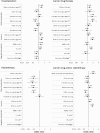Delivery of health care at the end of life in cancer patients of four swiss cantons: a retrospective database study (SAKK 89/09)
- PMID: 24885104
- PMCID: PMC4101827
- DOI: 10.1186/1471-2407-14-306
Delivery of health care at the end of life in cancer patients of four swiss cantons: a retrospective database study (SAKK 89/09)
Abstract
Background: The use of cancer related therapy in cancer patients at the end-of-life has increased over time in many countries. Given a lack of published Swiss data, the objective of this study was to describe delivery of health care during the last month before death of cancer patients.
Methods: Claims data were used to assess health care utilization of cancer patients (identified by cancer registry data of four participating cantons), deceased between 2006-2008. Primary endpoints were hospitalization rate and delivery of cancer related therapies during the last 30 days before death. Multivariate logistic regression assessed the explanatory value of patient and geographic characteristics.
Results: 3809 identified cancer patients were included. Hospitalization rate (mean 68.5%, 95% CI 67.0-69.9) and percentage of patients receiving anti-cancer drug therapies (ACDT, mean 14.5%, 95% CI 13.4-15.6) and radiotherapy (mean 7.7%, 95% CI 6.7-8.4) decreased with age. Canton of residence and insurance type status most significantly influenced the odds for hospitalization or receiving ACDT.
Conclusions: The intensity of cancer specific care showed substantial variation by age, cancer type, place of residence and insurance type status. This may be partially driven by cultural differences within Switzerland and the cantonal organization of the Swiss health care system.
Figures



Similar articles
-
Cancer-related therapies at the end of life in hospitalized cancer patients from four Swiss cantons: SAKK 89/09.Oncology. 2015;88(1):18-27. doi: 10.1159/000367629. Epub 2014 Sep 26. Oncology. 2015. PMID: 25277324
-
Days spent in acute care hospitals at the end of life of cancer patients in four Swiss cantons: a retrospective database study (SAKK 89/09).Eur J Cancer Care (Engl). 2017 Jul;26(4). doi: 10.1111/ecc.12453. Epub 2016 Feb 9. Eur J Cancer Care (Engl). 2017. PMID: 26856977
-
Death at no cost? Persons with no health insurance claims in the last year of life in Switzerland.BMC Health Serv Res. 2018 Mar 14;18(1):178. doi: 10.1186/s12913-018-2984-2. BMC Health Serv Res. 2018. PMID: 29540161 Free PMC article.
-
Place of death and health care utilization for people in the last 6 months of life in Switzerland: a retrospective analysis using administrative data.BMC Health Serv Res. 2013 Mar 25;13:116. doi: 10.1186/1472-6963-13-116. BMC Health Serv Res. 2013. PMID: 23530717 Free PMC article.
-
Involuntary outpatient treatment for mental health problems in Switzerland: a literature review.Int J Soc Psychiatry. 2014 Nov;60(7):695-702. doi: 10.1177/0020764013513439. Epub 2013 Dec 18. Int J Soc Psychiatry. 2014. PMID: 24351963 Review.
Cited by
-
What are determinants of utilisation of pharmaceutical anticancer treatment during the last year of life in Norway? A retrospective registry study.BMJ Open. 2021 Sep 27;11(9):e050564. doi: 10.1136/bmjopen-2021-050564. BMJ Open. 2021. PMID: 34580099 Free PMC article.
-
Regional Variation of Cost of Care in the Last 12 Months of Life in Switzerland: Small-area Analysis Using Insurance Claims Data.Med Care. 2017 Feb;55(2):155-163. doi: 10.1097/MLR.0000000000000634. Med Care. 2017. PMID: 27579912 Free PMC article.
-
Cost-effectiveness and budget impact of venetoclax in combination with rituximab in relapsed/refractory chronic lymphocytic leukemia in Switzerland.Eur J Health Econ. 2022 Jul;23(5):837-846. doi: 10.1007/s10198-021-01398-7. Epub 2021 Nov 10. Eur J Health Econ. 2022. PMID: 34757508 Free PMC article.
-
Cancer care near the end-of-life in Austria: A retrospective data analysis.Eur J Cancer Care (Engl). 2021 Jul;30(4):e13423. doi: 10.1111/ecc.13423. Epub 2021 Feb 7. Eur J Cancer Care (Engl). 2021. PMID: 33554389 Free PMC article.
-
[End-of-life therapy for patients dying with cancer: a retrospective database study].Wien Med Wochenschr. 2018 Oct;168(13-14):344-349. doi: 10.1007/s10354-018-0631-5. Epub 2018 Mar 13. Wien Med Wochenschr. 2018. PMID: 29536254 German.
References
-
- Earle CC, Neville BA, Landrum MB, Ayanian JZ, Block SD, Weeks JC. Trends in the aggressiveness of cancer care near the end of life. J Clin Oncol. 2004;22(2):315–321. - PubMed
Publication types
MeSH terms
LinkOut - more resources
Full Text Sources
Other Literature Sources

